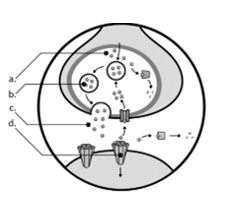Which is NOT a type of protein?
Fibrous
Membrane
Globular
Unsaturated
Correct Answer : D
There are three types of proteins: fibrous, membrane, and globular. Fibrous or structural proteins consist of collagen, elastin, and keratin. Membrane proteins are interactive and anchored to a membrane. Globular proteins consist of functional proteins like enzymes, hemoglobin, and insulin.
Therefore unsaturated is the correct answer.
TEAS 7 Exam Quiz Bank
HESI A2 Exam Quiz Bank
Find More Questions 📚
Teas 7 Questions: We got the latest updated TEAS 7 questions
100% Money Refund: 100% money back guarantee if you take our full
assessment pass with 80% and fail the actual exam.
Live Tutoring: Fully customized live tutoring lessons.
Guaranteed A Grade: All students who use our services pass with 90%
guarantee.
Related Questions
Correct Answer is A
Explanation
Phenotype is the physical presentation of an organism's genes. In other words, the phenotype is the physical characteristics of the organism. Phenotype is often contrasted with genotype, the genetic makeup of an organism. The genotype of the organism is not visible in its presentation, although some of the characteristics encoded in the genes have to do with physical presentation. A phylum is a group of classes that are closely related. A species is a group of like organisms that are capable of breeding together and producing similar offspring.
Correct Answer is A
Explanation
Two genes next to each other (or within a specified close distance) are said to be linked. Linked genes do not follow the law of Independent assortment because they are too close together to be segregated from each other in meiosis.
Correct Answer is C
Explanation
The uterus has three layers. The inner layer is called the endometrium. The middle layer is called the myometrium. The outer layer of the uterus is called the serosa or perimetrium.
Correct Answer is A
Explanation
The pituitary and the pancreas are both structures of the endocrine system that produce hormones involved in body regulation, growth reaand development, sexual functioning, and other processes. The penis Is a structure of the reproductive system that responds to hormones, but it does not produce them. The prostate plays a role in converting testosterone (produced in the testicles) into dihydrotestosterone, but does not actively produce hormones. The pons is located in the brain stem and relays nerve signals that coordinate messages between the brain and the body. The pericardium is a structural component of the cardiovascular system.
Correct Answer is B
Explanation
The evidence says that every child in a certain family has been diagnosed with autism spectrum disorder (ASD). All of these children have genetic commonalities. Therefore, ASD may be genetic.
The evidence does not mention whether the children died from ASD. Therefore, no conclusion can be drawn that ASD may be lethal. Furthermore, the sample size of the evidence is much too small to suggest that ASD is related to traditional nuclear family structures.
Correct Answer is D
Explanation
Of these orbitals, the last to fill is 6s.
Orbitals fill in the following order: 1s, 25, 2p. 35, 3p, 4s, 3d, 4p, 55, 4d, 5p. 6s, 4f, 5d, 6p. 7s, 5f, 6d, and 7p. The number is the orbital number, and the letter is the sublevel identification. Sublevels has one orbital and can hold a maximum of two electrons. Sublevel p has three orbitals and can hold a maximum of six electrons. Sublevel d has five orbitals and can hold a maximum of 10 electrons, Sublevel f has seven orbitals and can hold a maximum of 14 electrons.
Correct Answer is D
Explanation
Enzymes act as catalysts for biochemical reactions. A catalyst is not consumed in a reaction, but rather lowers the activation energy for that reaction. The potential energy of the substrate and the product remain the same, but the activation energy-the energy needed to make the reaction progress can be lowered with the help of an enzyme.
Correct Answer is B
Explanation
Area B is asynaptic vesicle where the neurotransmitters are stored just before use.

Correct Answer is C
Explanation
There are four major types of carbohydrates: monosaccharides, disaccharides, oligosaccharides, and polysaccharides. Monosaccharides (mono- means one) are made up of one sugar molecule, while disaccharides (di- means two) are made up of two sugar molecules. Oligosaccharides (oligo- means few) are usually less than a dozen sugar molecules, while polysaccharides (poly-means many) are usually more than a dozen sugar molecules.
Pentasaccharides are not a type of carbohydrate.
Correct Answer is A
Explanation
Maintaining homeostasis means that conditions are kept stable and relatively constant. Negative feedback is a mechanism used to reverse or minimize changes in a system. In this example, negative feedback is used to keep the body's glucose and insulin levels stable. Positive feedback (B) is a mechanism that Increases changes in a system. A stress response (C) describes the body's reaction to threats or pressures. Parasympathetic regulation (D) refers to activities of the nervous system, including slowing the heart rate and boosting Intestinal activity.
This question was extracted from the actual TEAS Exam. Ace your TEAS exam with the actual TEAS 7 questions, Start your journey with us today
Visit Naxlex, the Most Trusted TEAS TEST Platform With Guaranteed Pass of 90%.
Money back guarantee if you use our service and fail the actual exam. Option of personalised live tutor on your area of weakness.
